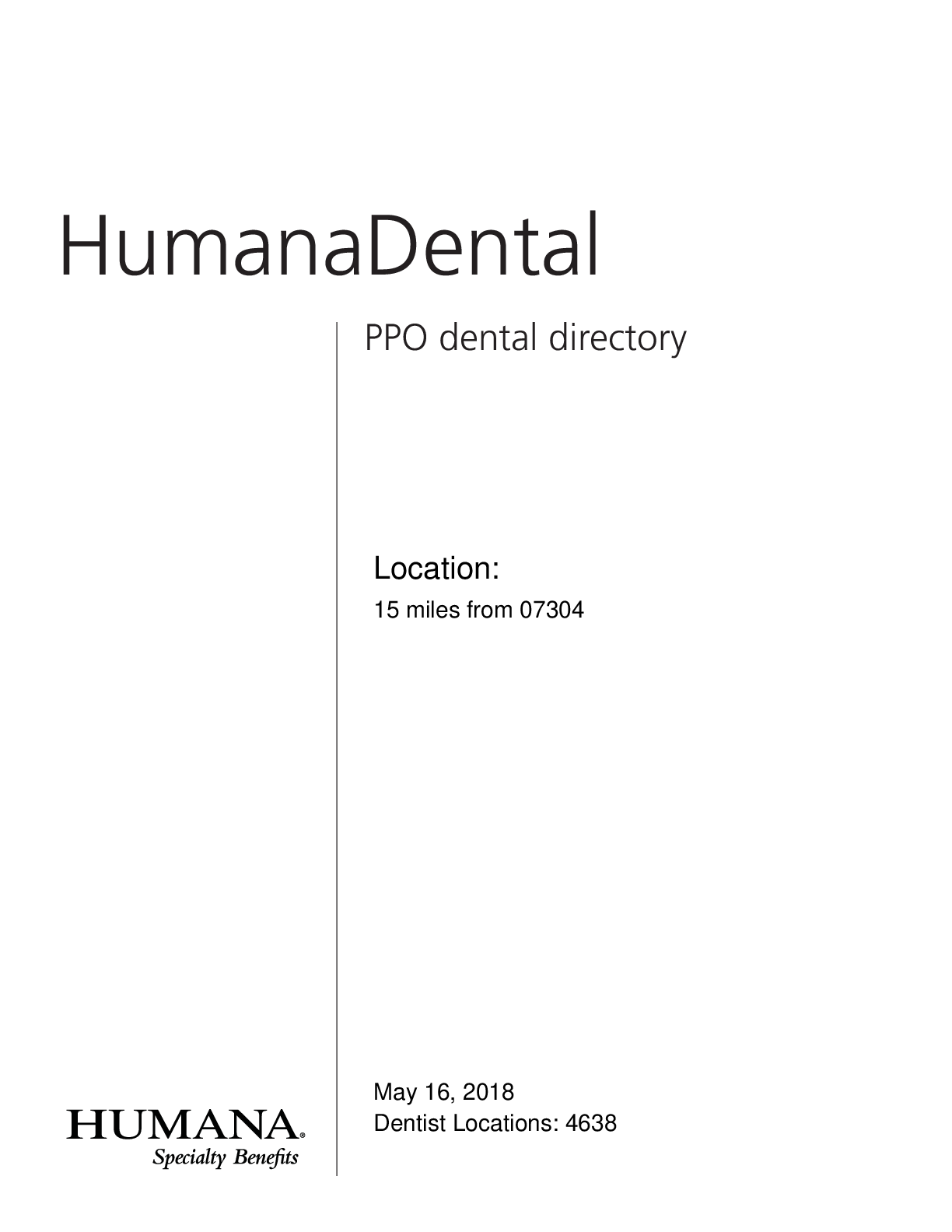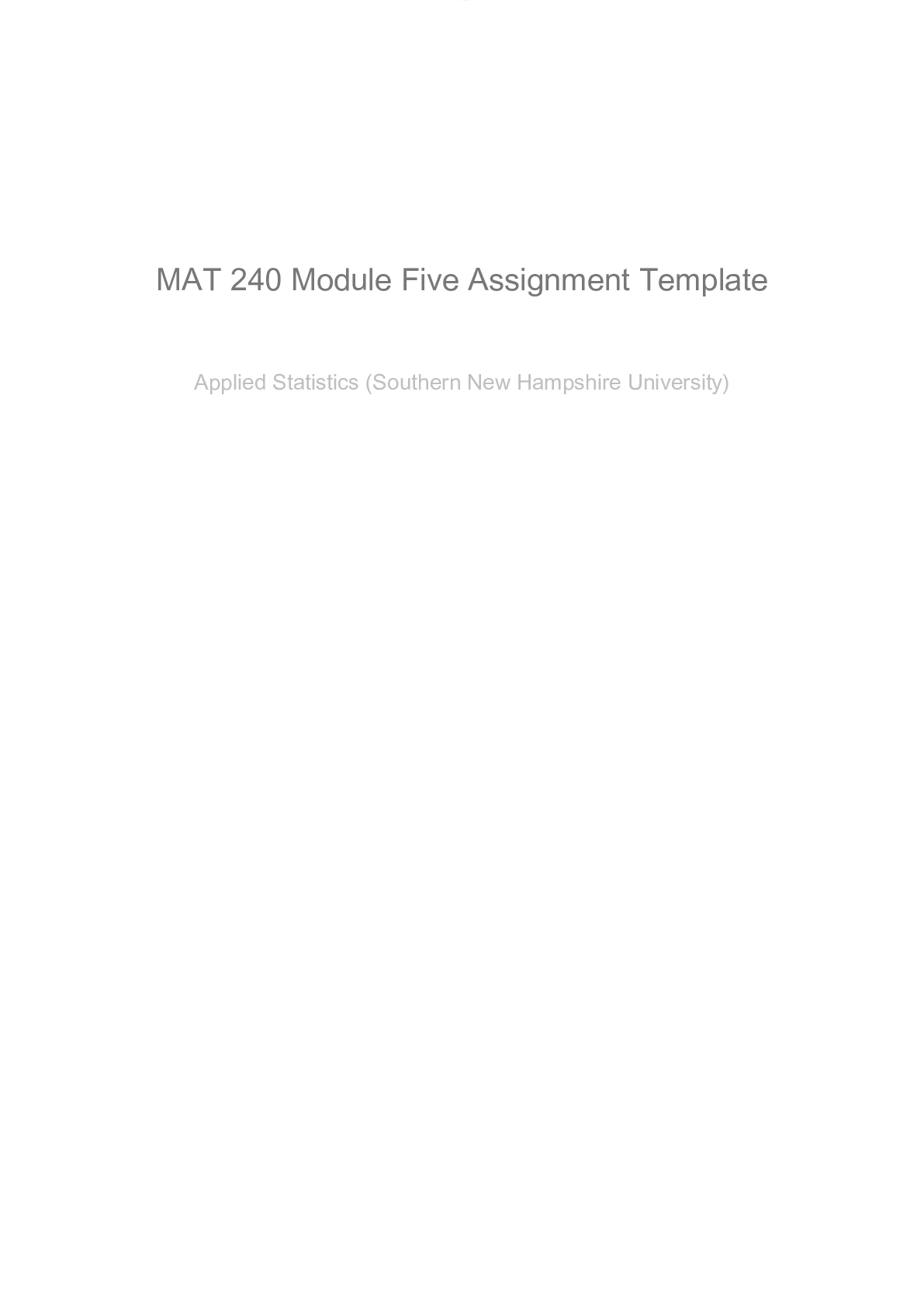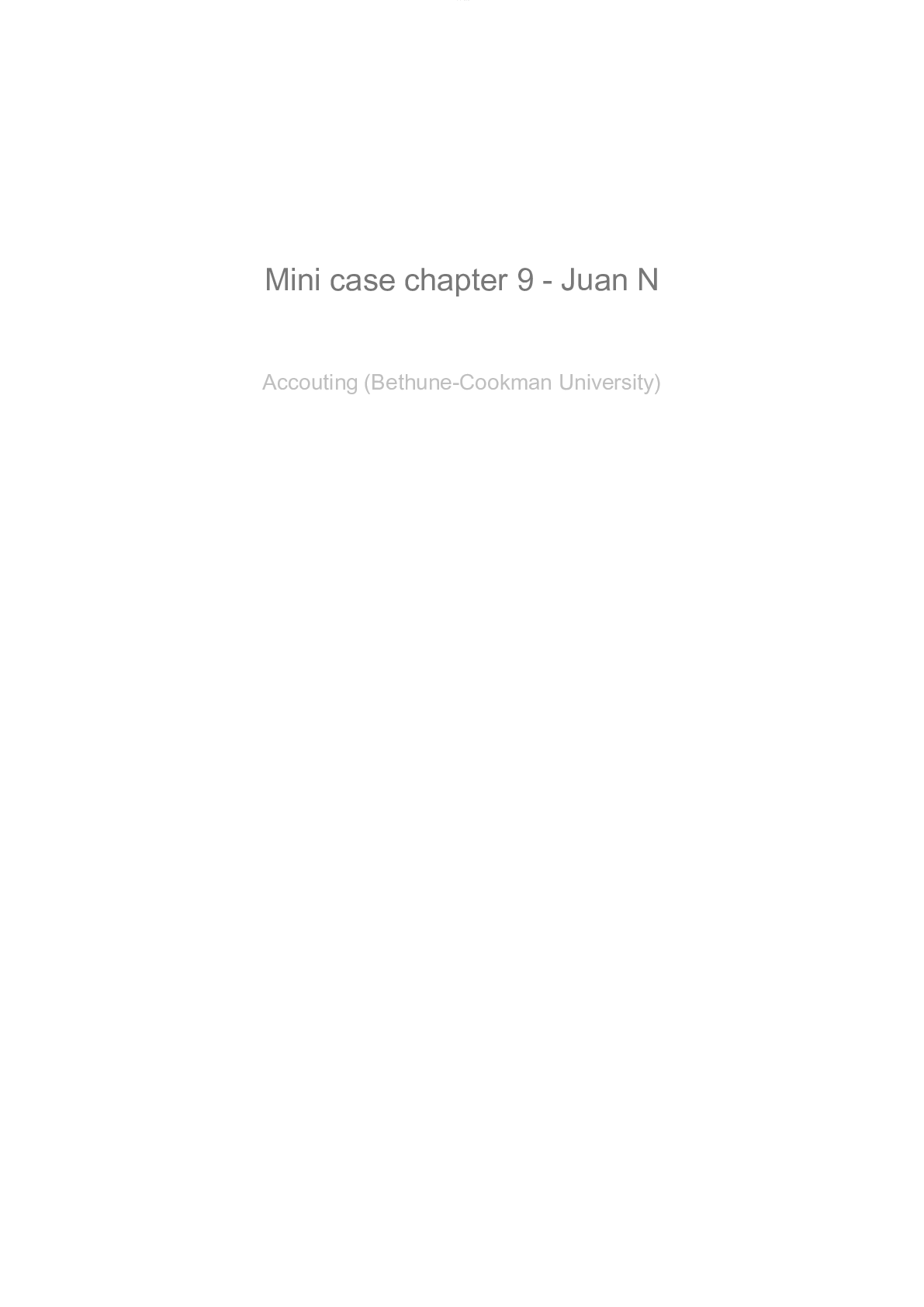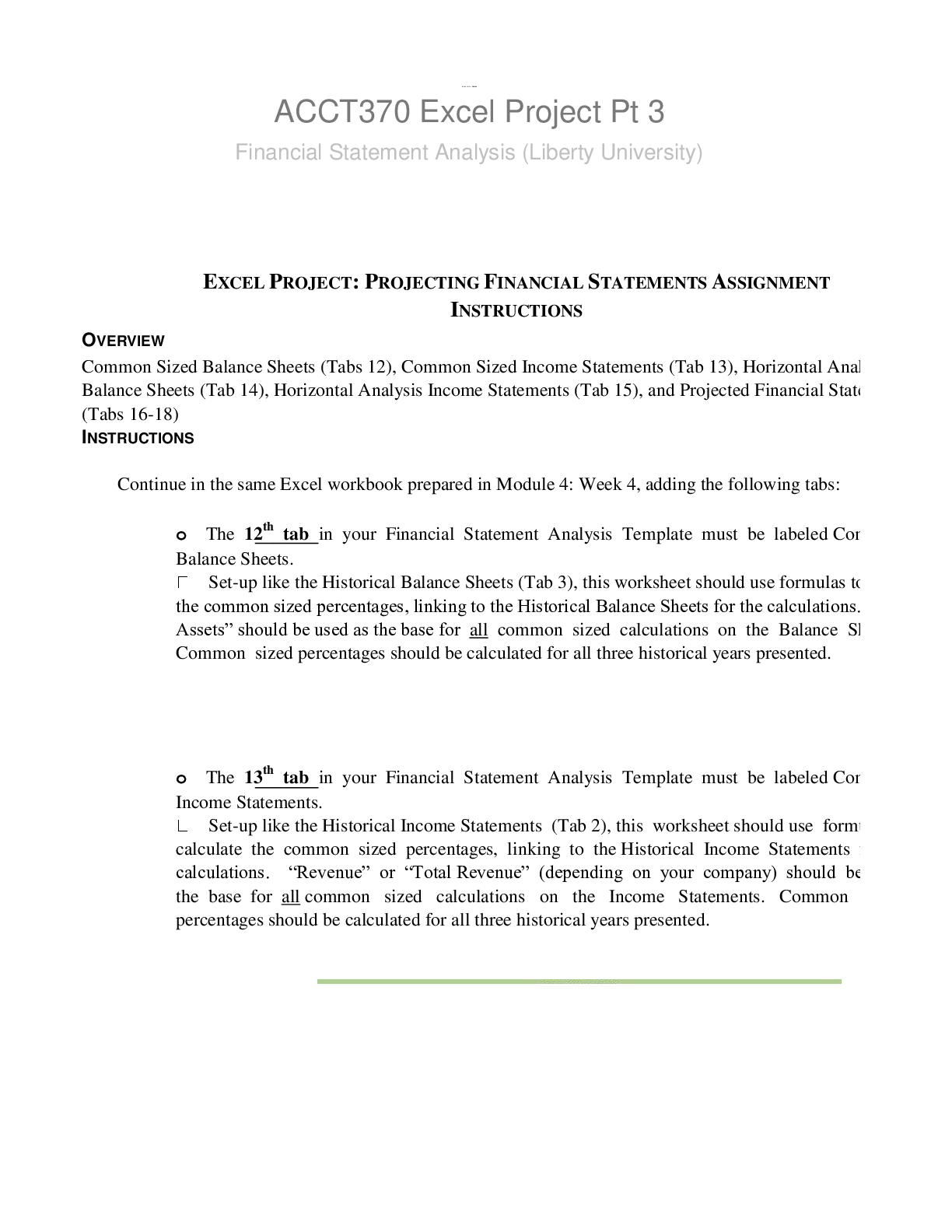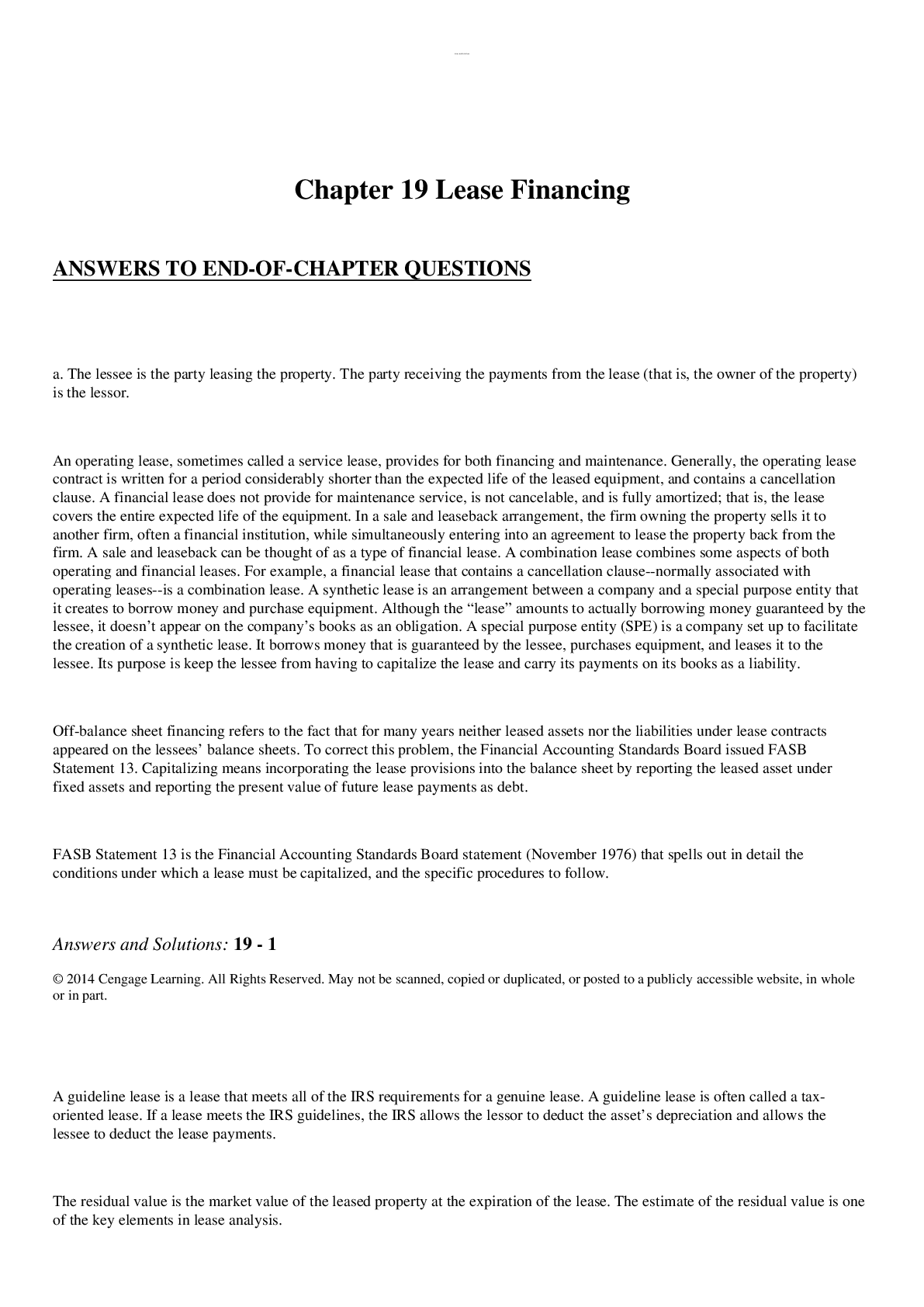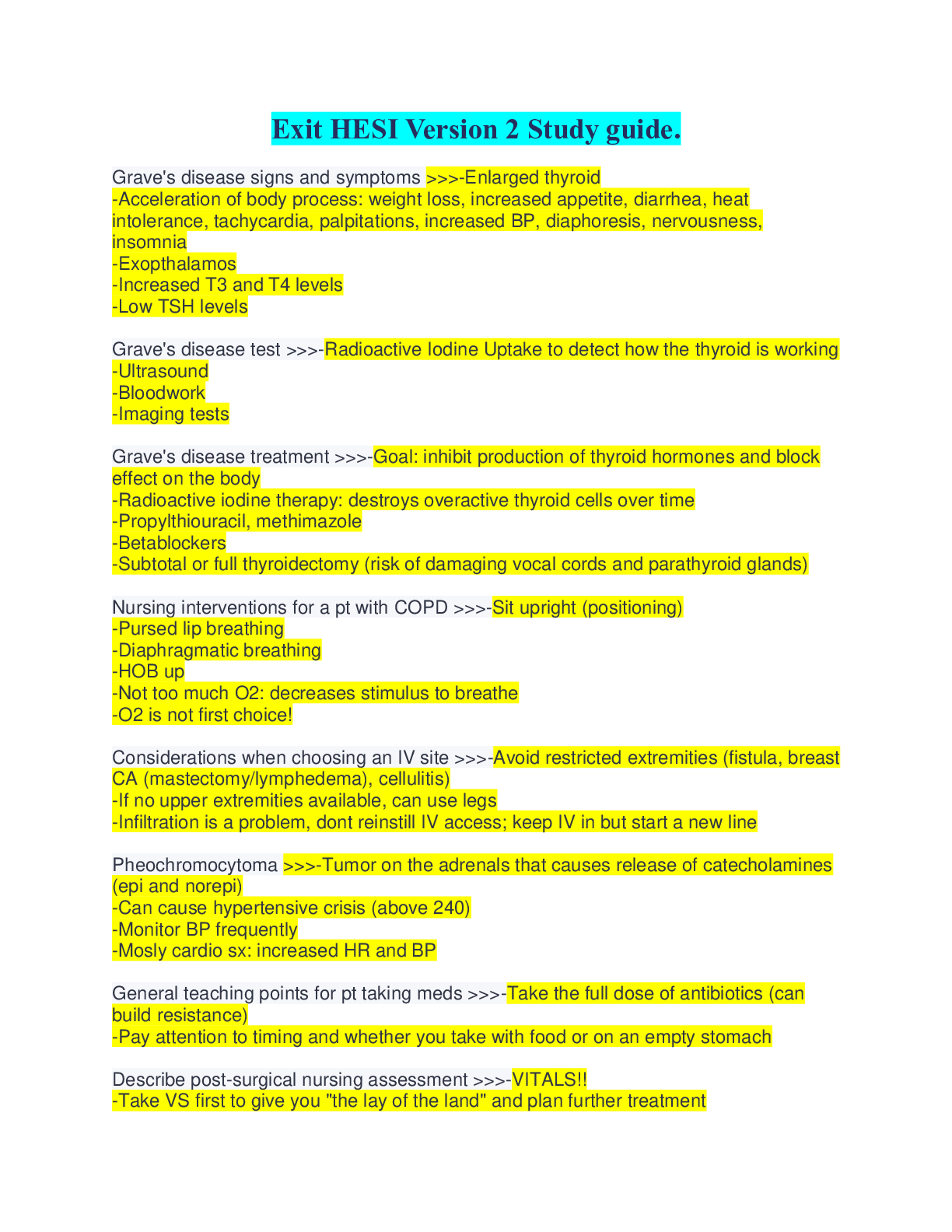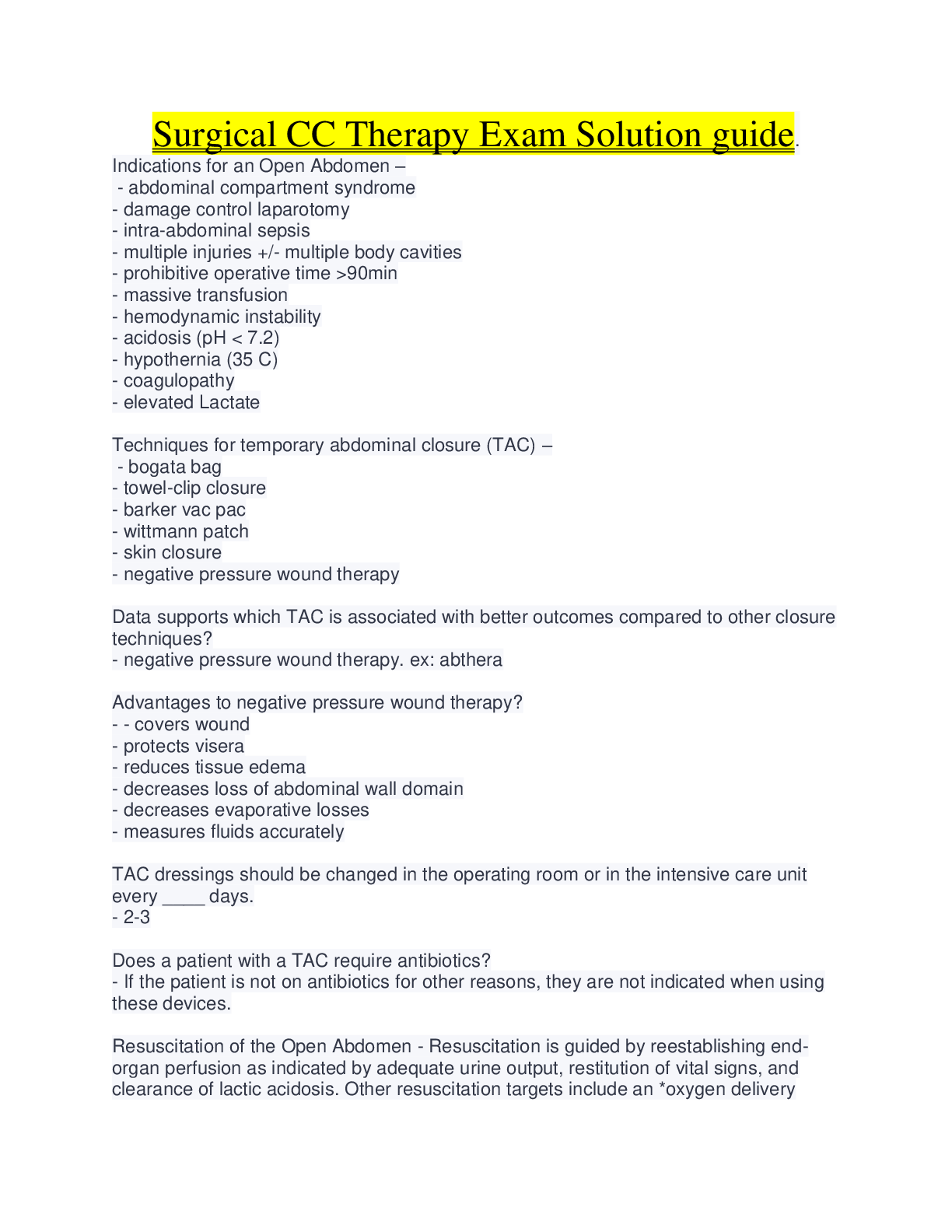Oncology > Solutions Guide > Rasmussen College NUR201 MDC4 Exam1 (All)
Rasmussen College NUR201 MDC4 Exam1
Document Content and Description Below
· With what we have… the test taker got 84% 1. No picture : D 2. No picture: B 3. No picture: B - constrict 4. No picture: D or C 5. A nurse is assessing a client in postoperative recovery. Th... e client complains of the following symptoms. Which of the following is abnormal and should be reported immediately? a. Emesis that is red b. Complaint of feeling cold c. Nausea d. Complaint of pain 6. A client's neurological status deteriorates over hours, and a craniotomy is performed to evacuate a hematoma. Which nursing intervention is indicated to help decrease the threat of increased intracranial pressure? a. Elevate the head of the bed 30 degrees b. Cluster nursing interventions to provide uninterrupted periods of rest c. Teach the client to cough and deep breathe to prevent the necessity for suctioning d. Teach the client to hold his breath and bear down while repositioning in bed. 7. A client presents to the emergency room with complaints of bilateral lower extremity loss of sensation that started in the feet but has now progressed to the knees and hips. The nurse interprets these symptoms to indicate an immediate workup for which of the following diseases? a. Myasthenia gravis b. Simple, partial seizure c. guillain- barre syndrome d. Cerebrovascular accident 8. The charge nurse is obtaining the client’s signature on a surgical consent form. The client states, I didn’t really understand what my surgeon explained, but I trust him completely, “which response by the charge nurse is correct? a. I need to contact your surgeon so your questions can be answered b. I can answer any questions that you might have regarding your surgery. c. As long as you are comfortable, then you may sign the consent form. d. Maybe you should call your surgeon to be sure it is okay to sign the consent. 9. A client has a head injury and is presenting with signs and symptoms of increased intracranial pressure. Which nursing intervention would be helpful in reducing this pressure? a. Place the neck in a neutral position to promote venous drainage b. Suction hourly to stimulate the cough reflex c. Add extra blankets to keep the client warm. d. Turn the client frequently to prevent skin impairment 10. A client has recently suffered a stroke with left-sided weakness. The nurse assesses for dysphagia, especially with thin liquids. Which nursing intervention is most helpful in assisting this patient to swallow safely? a. The client should avoid all liquids. b. Instructing to tuck the chin when swallowing c. Give sips of water with each bite d. Turn head to the left. 11. A client has a comminuted fracture of T6-T7, resulting in paraplegia. The nurse educates the client on preventing autonomic dysreflexia. Which of the following is the priority intervention in this medical emergency?a. Scheduled bladder and bowel training b. Choosing foods to prevent nausea c. Avoiding food allergies d. Preventing electrolyte imbalances 12. The nurse develops a care plan for a client recovering from surgery. What nursing interventions will the nurse include to minimize the effects of venous stasis? a. Pillows under the knee in a position of comfort b. Sitting with feet flat on the floor c. Early ambulation d. Gentle leg massage 13. The client has an order for 0.45% sodium chloride 1 liter to infuse over 15 hours.At what rate in mL/hr would the nurse set the infusion pump? (Round to the nearest whole number, do not use a trailing zero.) 67mL/hr 14. A client with multiple sclerosis (MS) is receiving baclofen. The nurse determines that the drug is effective when it causes which action? a. Induces sleep b. Stimulates the client’s appetite c. Relieves muscular spasticity d. Reduces the urine bacterial count 15. Sudden chest pain combined with dyspnea, cyanosis, and tachycardia are symptoms associated with which of the following complications of surgery? a. Hypovolemic shock b. Dehiscence c. Atelectasis d. Pulmonary embolus 16. A client presents to the emergency department with signs of a stroke. After a computed tomography (CT) scan, which revealed a hemorrhage, the nurse anticipates directives for which one of the following plans? a. TPA administration a. Call a code blue b. Prep for a client surgery c. Place the client in Trendelenburg 17. A client arrives in the emergency department with an ischemic stroke. Because the healthcare team is considering tissue plasminogen activator (tPA), what should the nurse perform FIRST? a. Ask what medications the client is taking b. Complete the history and health assessment c. Identify the time of onset of the stroke d. Determine if the client is scheduled for any surgical procedures 18. The client has presented with a basilar skull fracture. While assessing the client, the nurse notes clear drainage from the nose with a “halo sign” and is concerned about a potential cerebrospinal fluid (CSF) leakage. What should the nurse do next? a. Document this as serous drainage and continue to monitor the client b. Check for the presence of glucose in the drainage and report to the provider c. Apply an ice pack to the nasal bridge and a large, fluffy dressing. d. Assist the client in blowing his nose to clear secretions and re-evaluate. 19. The nurse is discussing different types of anesthesia with a group of nursing students. The student nurse correctly identifies which type of anesthesia requires both inhalation and IV administration routes?a. General b. Regional c. Specific d. Preoperative 20. The nurse is evaluating a client with a head injury and finds drainage from the client’s nose and ears. Which of the following is the priority teaching for this client? a. Cleanse the ear and nose with a soft cotton tipped swab and hydrogen peroxide b. Gently suction the nasal cavity to reduce the amount of secretions c. Wipe the nose or ears, but do not blow the nose or place anything in the ear d. Place a pressure dressing over the affected areas to reduce leakage. 21. The nurse is assisting with the sponge and instrument count in the operating room. Which operative phase does this occur in? a. Perioperative phase b. Preoperative phase c. Intraoperative phase d. Postoperative phase 22. A client has been diagnosed with an ischemic stroke. The nurse realizes this client cannot have fibrinolytic therapy until which vital sign is addressed and treated? a. Blood pressure of 220/120 mm HG b. Oxygen saturation of 92% c. A heart rate of 86 bpm d. RR of 24 bpm 23. During a nutritional therapy class, the nurse educates a group of migraine sufferers on foods that may worsen headaches. The clients are advised to avoid which of the following food choices? (SATA) a. Yogurt b. Caffeine c. Beef d. Pears e. Marinated food f. milk 24. The nurse is caring for a client with Parkinson's disease. Which intervention does the nurse implement to prevent respiratory complications in the client? a. Keep an oral airway at the bedside b. Ensure fluid intake of at least 3L/day c. Teach the client pursed lip breathing techniques d. Maintain the head of bed at 30 degrees or greater 25. A client has been injured in a motorcycle accident and is presenting with signs and symptoms of increased intracranial pressure. What is the most significant sign or symptom of increased intracranial pressure? a. Pupil changes b. Ipsilateral paralysis c. Vomiting d. Decrease in the level of consciousness 26. The nurse is caring for a client diagnosed with Alzheimer’s disease. Which nursing tasks should not be delegated to the unlicensed assistive personnel (UAP)? (SATA) a. Check the client’s skin under the restraints b. Administer the clients antipsychotic medication c. Perform the client’s morning hygiene care d. Ambulate the client to the bathroom e. Obtain the clients routine vital signs27. The nurse is assessing a client with Alzheimer's disease. Which finding places the client in the moderate stage of the disease process? Select all that apply a. Wandering b. Anger c. incontinence of bowel and bladder d. Visuospatial deficit e. violent episodes 28. Which medication will the nurse prepare to administer to the client who is experiencing status epilepticus? a. phenobarbital b. lorazepam c. Chlordiazepoxide d. Phenytoin 29. A nurse is explaining safe eating practices to a wife who will be caring for her husband, who has been diagnosed with hemiplegia following his stroke. The nurse develops the discharge teaching and identifies which of the following actions to promote safe feeding practices for the client? Select all that apply a. mixing liquid and solid foods together b. taking the client's dentures out to prevent choking c. offering small bites of food d. checking the affected side of the mouth for food accumulation e. elevating the client to no more than 30 degrees f. adding a thickening agent to liquid's 30. while assessing a post-op client, the nurse alerts the physician for a wound evisceration. While waiting for further direction the nurse understands which of the following interventions needs to be done immediately question marks a. place the client in how high fowler's position b. give the client fluids to prevent shock c. replacing the dressing with sterile fluffy pads d. apply a warm, moist normal Saline sterile dressing31. During the course of surgery, a client exhibits tachycardia, diaphoresis, and rising body temperature. Which of the following is the priority intervention of the circulating nurse? a. Continue to monitor the client for any further changes in condition b. note the client's oxygen saturation in blood pressure c. ask the scrub nurse to verify the assessment findings d. alert the anesthesiologist and surgeon immediately 32. when planning care for a client with myasthenia gravis , the nurse understands that the client is at highest risk for which of the following? a. Aspiration b. bladder dysfunction c. hypertension d. sensory loss 33. a client has been diagnosed with organic brain pathology. He is presenting with signs and symptoms of total or partial loss of the ability to recognize familiar objects or people through sensory stimulation. The nurse correctly identifies the signs and symptoms as which of the following? a. Apraxia b. Agnosia c. aphasia d. dysphagia 34. The nurse is assessing a client with Parkinson's disease who is beginning to display Bradykinesia. Which of the following statements from the client indicates an understanding of the disease? a. I need to take larger, faster steps when I ambulate b. I should stop my routine exercises to avoid the potential for injury c. I need to allow extra time to complete activities ‘ d. Bradykinesia will only affect my extremities as my disease progresses 35. A nurse is caring for a client who has a closed head injury with intracranial pressure (ICP) readings between 16 and 22MM HG. Which of the following actions should the nurse take to decrease the potential for raising the client's AICP? Select all that apply a. sucton the endotracheal tube frequentlyb. decrease the noise in the client's room c. elevate the clients head on two pillows d. administer a stool softener e. keep the client well hydrated 36. the nurse determines that the client demonstrates an understanding of preoperative teaching with which response? Select all that apply a. I will need to sign a consent form before I am given my medications prior to my surgery b. the surgeon will want me to ambulate as soon as possible after my surgery c. the nurse will want me to take the deepest breaths I can tolerate following my surgery d. I may experience some Constipation if I am taking much pain medication after my surgery e. the general anesthesia will prevent me from having pain for the first 24 hours after surgery 37. Myasthenia gravis (MG) is an autoimmune disease of the neuromuscular junction characterized by the fluctuating weakness of certain skeletal muscle groups. The use of intravenous immune globulin is for which response? a. Increases anxiety and depression b. reduces the production of acetylcholine antibodies c. Removes the antibodies produced by the autoimmune response. d. increases the production of acetylcholine antibodies. 38. A nurse is preparing a teaching plan for a client with migraine headaches who has been prescribed a beta blocker daily to help manage this disorder. Which instructions would be appropriate to relay to this client? a. Take this drug only when you have prodromal symptoms indicating the unsent of a migraine headache b. take this drug as ordered, even when filling well, to prevent vascular changes associated with migraine headaches. c. This drug will relieve the pain during the Aurora phase soon after a headache has started d. this medication is prescribed for migraines, you won't experience any effect on your heart rate or blood pressure39. the nurse is obtaining a health history for a 45 year old woman with Guillain-Barre syndrome (BGS). Which statement by the client does the nurse correlate with the clients diagnosis? a. I have a history of a cardiac dysrhythmias b. I just got over the flu a couple of weeks ago and now this c. my neighbor also has Guillain-Barre syndrome d. I am an artist and work with oil paints 40. Hey client is admitted to the neurological unit after having had three tonic clonic seizures in the past two days. Her husband reported that she had been sleeping for long periods after each seizure. The nurse explains to him that this rest period after a tonic clonic seizure is which of the following? a. Convalescent. Convulsant. b. Post status epilepticus period c. Post tonic clonic period d. postictal period 41. The three components of cushing's response (triad) are which of the following? Select all that apply a. decreased blood pressure b. widened pulse pressure c. Bradycardia d. increased systolic blood pressure e. uncontrolled thermal regulation 42. A client with new onset status epilepticus is prescribed phenytoin. Ever teaching the client about this treatment regimen , the nurse assesses the client's understanding. Which statement indicates that the client understands the teaching? a. I must drink at least 2 liters of water daily b. this will stop me from getting an aura before a seizure c. I will not be able to be employed while taking this medication d. even when my seizures stop, I will take this drug.. 43. C: Chart the clients level of consciousness as coma 44. A nurse is providing teaching to a class about transient ischemic attacks (TIAs). Which information should the nurse include in the teaching? a. A TIA can cause irreversible hemiparesis b. A TIA can be the result of cerebral bleeding c. A TIA can cause cerebral edema d. A TIA can precede an ischemic stroke 45. The nurse enters a room and witnesses a client experiencing a seizure. What is the nurse's priority actions? a. Establish a large-bore catheter and start 0.9% sodium chloride b. Start the client on 8L of oxygen via non-rebreather mask c. Place the client in the supine, left- lateral position d. Remove items that may cause client injury 46. A nurse is developing a care plan for a client with bacterial meningitis. Which of the following interventions will reduce the risk of increased intracranial pressure? a. Initiate seizure precautions per facility protocol b. Assess glasgow Coma scale once per shift c. Keep the head of the bed elevated as high as tolerated d. Start 0.9% normal saline at 75 ml/hr via peripheral IV 47. Which of the following statements by your client’s son indicate the need for further teaching when using patient controlled analgesia (PCA)? a. The medication is flowing through my mothers intravenous line b. I can push the button for my mother if she is too drowsy c. My mother or I should notify the nurse if her pain is uncontrolled while using the PCAd. My mother will push the PCA button when she is experiencing increased pain 48. In preparing the client for abdominal surgery, the nurse delegates which tasks to the unlicensed assistive personnel? (Select all that apply) a. Vital signs b. Insertions of nasogastric tube (NGT) c. Height and weight d. Obtain operative consent e. Sterile gowning 49. The nurse is educating a client on the types of anesthesia used in surgery. Which client statement indicates a correct understanding of the topic? a. I am having general anesthesia, so I will be given a gas to breathe and medication in my IV b. I may still be aware of what’s happening with general anesthesia c. An epidural is used for general anesthesia d. When I had my skin cancer removed on my leg, the doctor used general anesthesia to numb this area. 50. A client has been admitted to the neurological department because of seizures of unknown cause. Which of the following is the priority intervention? a. Placing the client in protective restaurants b. Being sure padded side rails are present c. Suggesting that the family monitor the client d. Placing the client with one on one nursing service 51. A client had an embolic stroke and is having an echocardiogram. When the client asks why the provider ordered “a test on my heart,” how will the nurse respond? a. Most of these types of blood clots come from the heart b. Some of the blood clots may have gone to your heart too c. We need to see if your heart is strong enough for therapy d. Your heart may have been damaged in the stroke too 52. As the result of a stroke, a client has difficulty discerning the position of his body without looking at it. In the nurses documentation, which would best describe the clients liability to assess the spatial position of the body? a. Agnosia b. Proprioception c. Apraxia d. Sensation 53. A client is having an epileptic episode and develops loss of consciousness, incontinence, and breathing cessation for 25 seconds, followed by a postictal state lasting 15 minutes. The nurse understands this client is suffering from which type of seizure activity? a. Atonic seizurea. Simple partial seizure b. Pseudoseizure c. Tonic clonic seizure 54. A client arrives at the emergency department with new onset slurred speech and weakness. The nurse inquires about when the client was last seen as normal. What other assessment information is critical for the health care team to know before a “stroke alert” can be initiated? a. client’s weight b. National Institutes of Health (NIH) stroke scale score c. Blood glucose level d. Vital signs 55. A nurse is preparing to administer heparin 3,500 units subcutaneously every 12 hours. The amount available is heparin injection 5,000 units/mL. How many mL should the nurse administer per dose? (record answer to the tenth (one decimal place). 0.7 56. A male client, age 69, is being evaluated by a neurologist for signs of muscle rigidity, masklike face (the area from the forehead to chin), and propulsive gait. The nurse interprets these findings as potential indicators of which neurological disorder? a. Multiple sclerosis b. Parkinson’s disease c. Alzheimer’s disease d. Epilepsy 57. Before undergoing a computed tomography (CT) scan with a contrast medium, the nurse assesses the client for which of the following potential complications? a. Assess that the client is not allergic to seafood or iodine. b. Determine the client’s ability to change position frequently during the procedure. c. Evaluate the ability to maintain a safe distance from the client to reduce the exposure to radiation. d. Confirm that the client has no metal objects such as an implant or a pacemaker. 58. The nurse is planning care for a client with epilepsy. Which precautions does the nurse implement to ensure the safety of the client while in the hospital. (select all that apply) a. Have suction equipment at the bedside b. place a padded tongue blade at the bedsidec. Permit only clear oral fluid d. Keep the bed rails up and padded at all times e. Maintain the client on strict bedrest. f. Ensure that the client has IV access 59. A nurse is conducting to pre-screening assessment on a client for Parkinson’s disease. The nurse understands which clinical manifestation may indicate this disease? a. Prepulsive forward movement b. Generalized profuse sweating c. Hyperactive behavior d. Decreased pain sensation 60. A child has been brought to the emergency department after a motor vehicle accident (MVA). The client has suffered traumatic injures and has no waveform on the electroencephalogram (EEG) Glasgow Coma Score is 3. The organ procurement team has been notified of a potential donor. Following protocols, the nurse performs, which of the following actions? a. maintain perfusion and care of the client to allow the possibility of a healthy organ harvest. b. Discuss the surgical harvesting and donation process with the family. c. Prepare to remove all lines and tubes to ensure a rapid transition to the OR after expiration. d. Remove any potentially nephrotoxic medications to preserve organ function for possible transplant. 61. A client presents to the emergency department (ED) with the inability to wrinkle her forehead or pucker her lips. She is afraid she may be having a stroke. After a complete clinical workup is negative for a cerebral vascular accident (CVA), the nurse provides discharge information on which of the following disorders? a. Trigeminal neuralgia b. Bell’s Palsy c. cerebral aneurysm d. Epilepsy 62. The nurse assesses a client who presents with progressive proximal to distal muscle weakness and mild diplopia. The nurse realizes these manifestations indicate the client most likely suffers from which peripheral nervous system disease?a. Systemic lupus erythematosus b. multiple sclerosis c. Guillan- barre syndrome d. Myasthenia gravis 63. The nurse explains which role is responsible for verifying that the consent form is signed and that the surgical site is marked? a. scrub nurse b. surgeon c. anesthesiologist d. circulating nurse 64. During the first 24 hours after thrombolytic treatment for an ischemic stroke, the nurse’s primary goal is to control which of the following vital signs? a. pulse b. respirations c. blood pressure d. temperature 65. The client who is to receive general anesthesia has a serum potassium level of 5.8 mEq/L. What should be the nurse’s first response? a. Call the operating room to cancel surgery b. Send the client to surgery c. Make a note on the client’s record d. Notify the surgeon 66. Which of the following is ture about the surgical scrub? a. It is completed before masking and after sterile gowning and gloving. b. It makes the skin sterile. c. Hands are dried with a laundered towel outside the surgical suite. d. It involves vigorous hand and lower arm scrubbing for 3-5 minutes.67. A client with Alzheimer’s disease is admitted to the hospital. Which psychosocial assessment is most important for the nurse to complete? a. Ability to recall past events b. Ability to perform self-care c. Reaction to a change of environment d. Relationship with close family members 68. A graduate nurse is performing discharge teaching for a client newly diagnosed with migraine headaches. Which statement made by the graduate nurse indicates a correct understanding of this disorder? a. Auras are not a symptom present with migraines. b. Beta blockers are contraindicated in clients with migraines c. Increasing stimulating activities during an episode will help resolve the migraines. d. Verapamil is not an abortive migraine medication but used to manage and prevent migraines. 69. A client with Parkinson’s disease is prescribed levodopa (l-dopa) therapy. Improvement in which area indicates the therapy is effective? a. Mood b. Muscle rigidity c. Appetite d. Alertness 70. The nurse is caring for a post-stroke client with expressive (Broca’s) aphasia. Which nursing intervention is appropriate for the nurse to communicate with the client? a. Refer the client to the speech language pathologist b. Speak loudly to help the client interpret what is being said c. Provide pictures or a communication board to help communicate d. Gesture the client to the required location or activity 71. During an assessment of a recent seizure client, the nurse interprets which finding is congruent with the postictal state? a. The client’s motor function is returning to baseline.b. The client state there is a visible aura. c. The client has brief jerking of the extremities. d. The client’s O2 saturation is 80%. s [Show More]
Last updated: 1 year ago
Preview 1 out of 17 pages
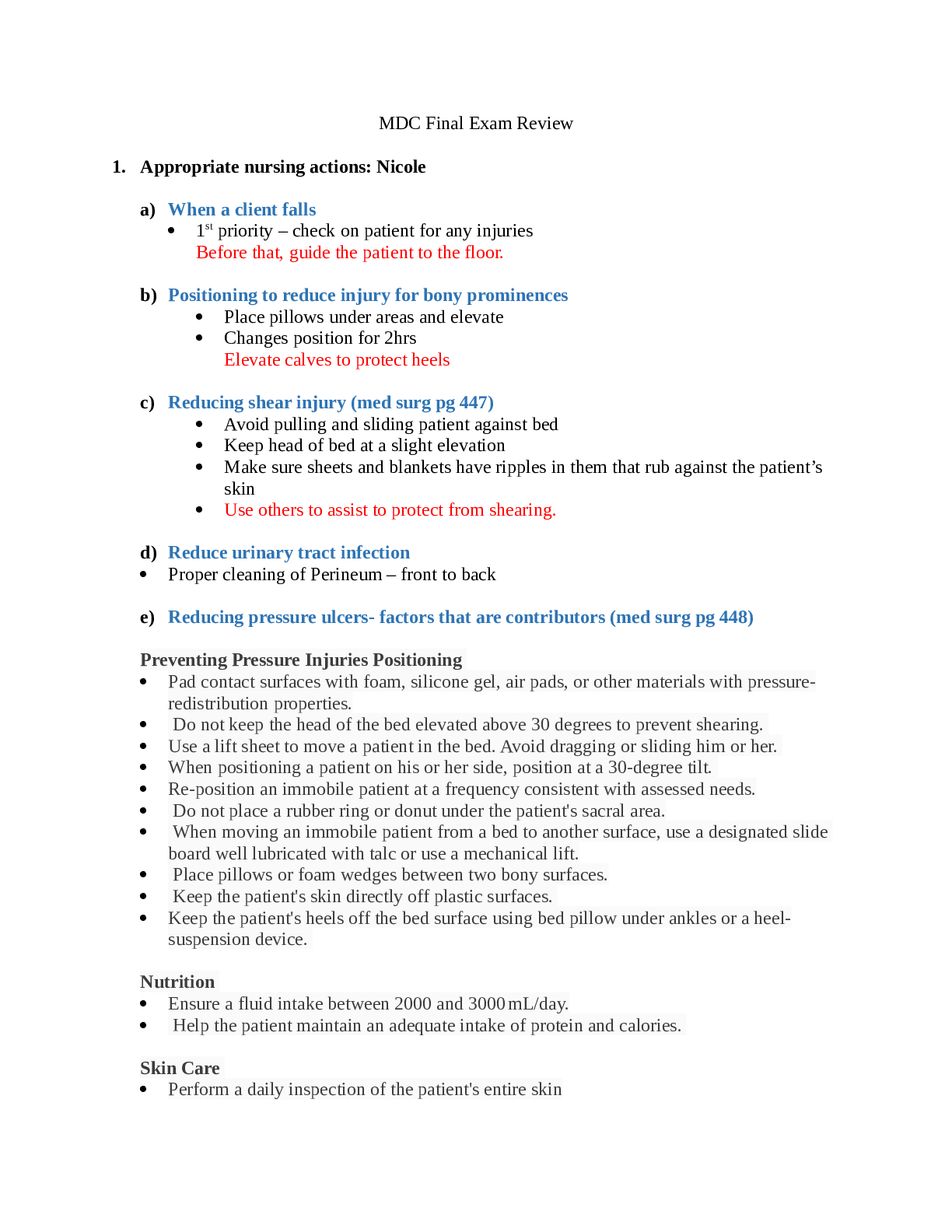
Reviews( 0 )
Document information
Connected school, study & course
About the document
Uploaded On
Nov 22, 2022
Number of pages
17
Written in
Additional information
This document has been written for:
Uploaded
Nov 22, 2022
Downloads
0
Views
36

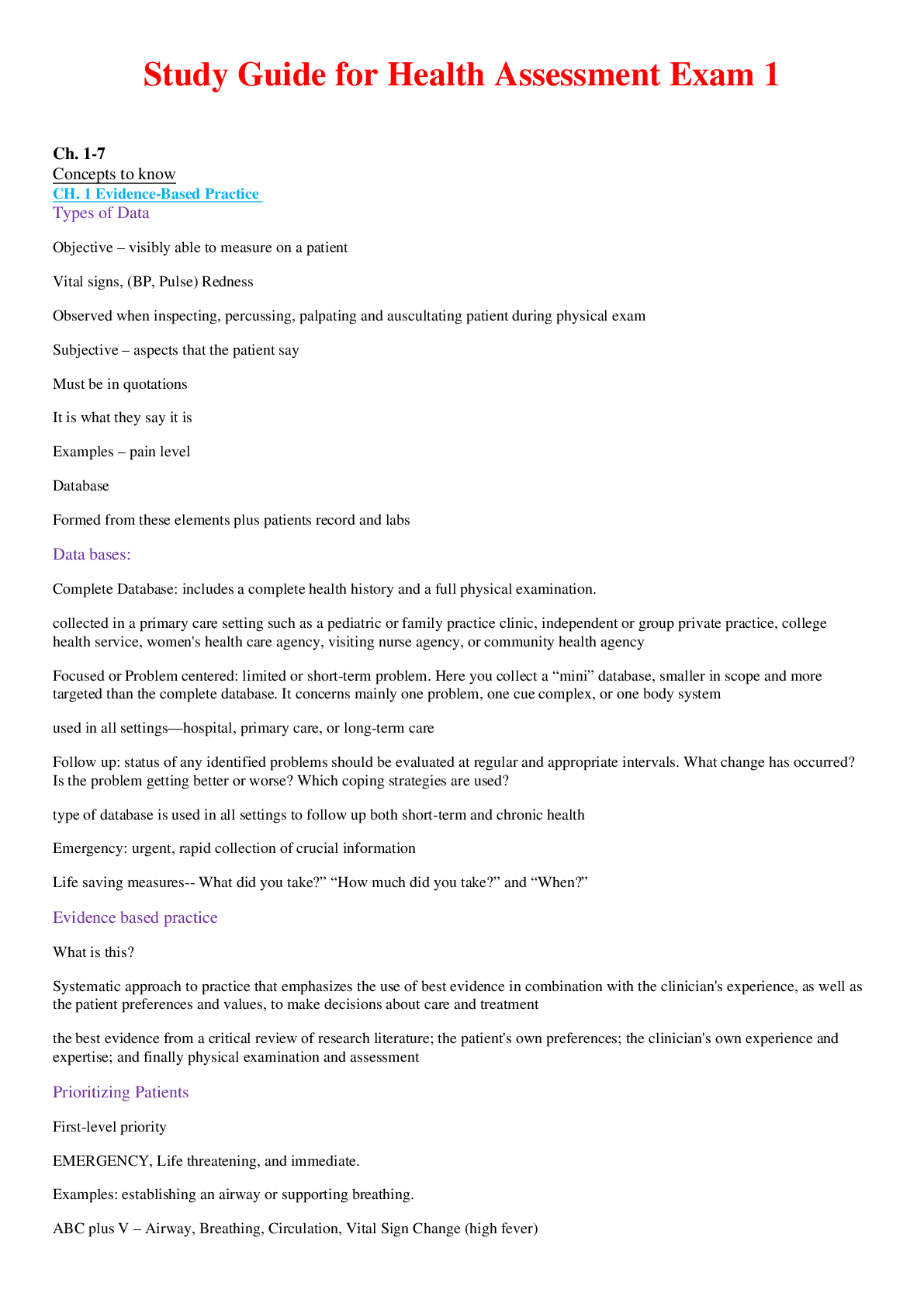
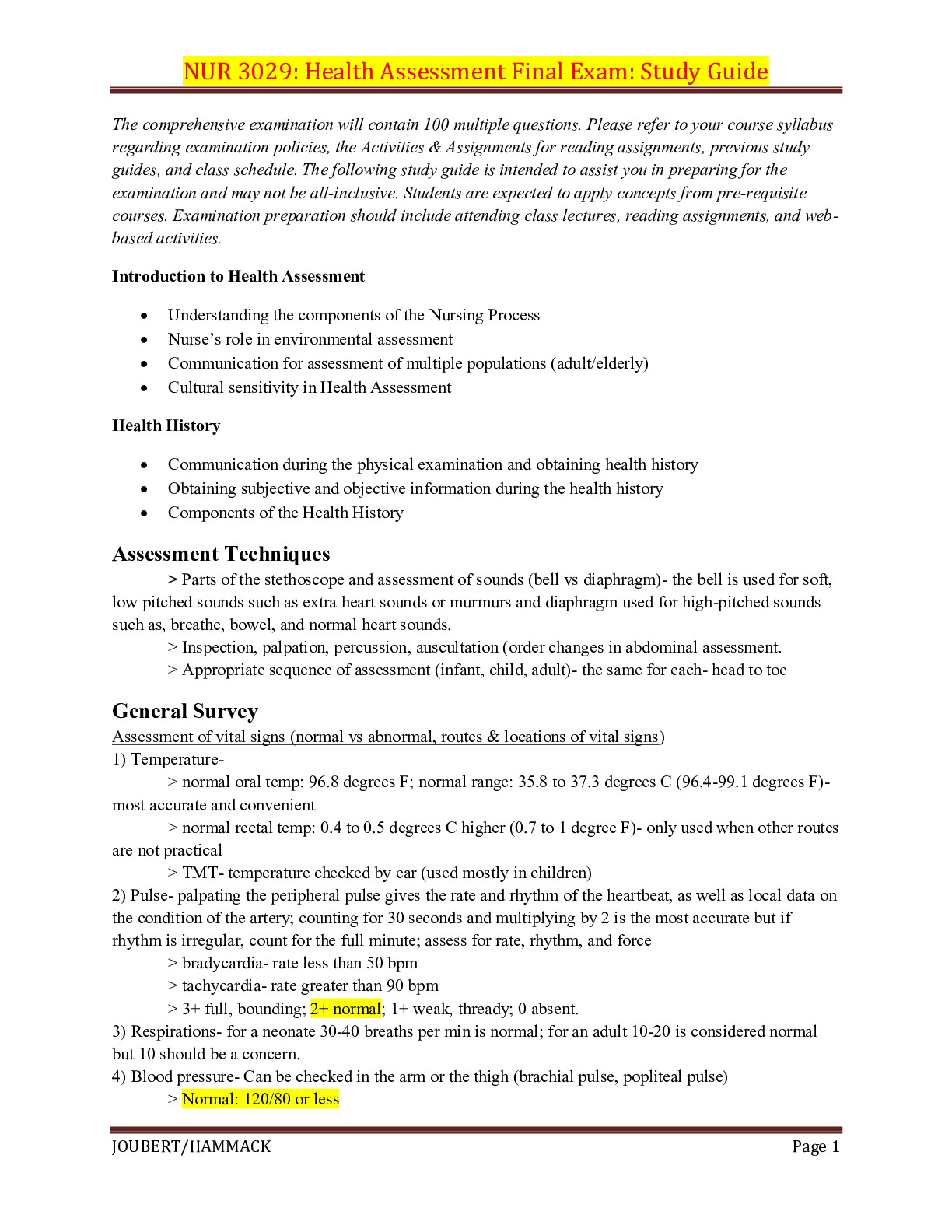
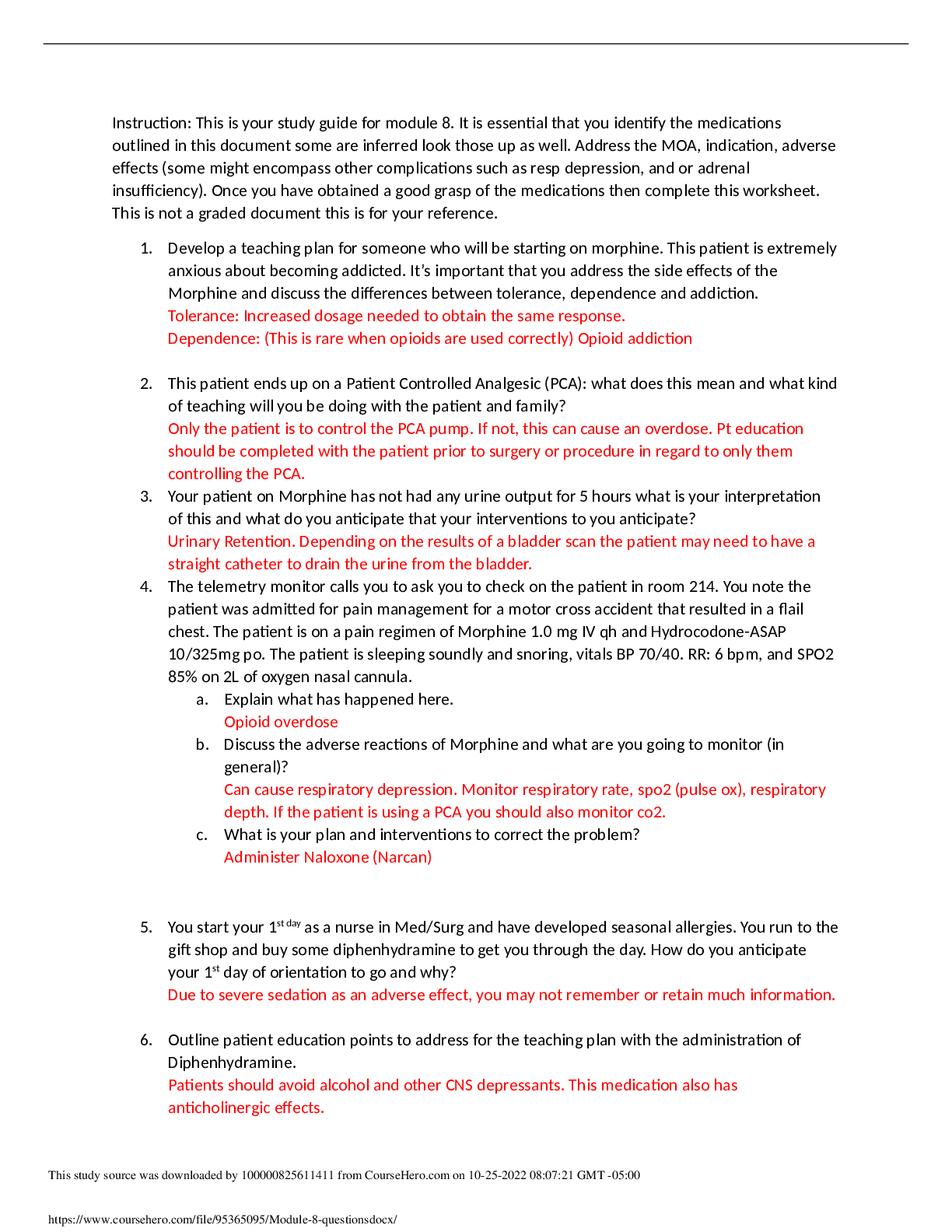
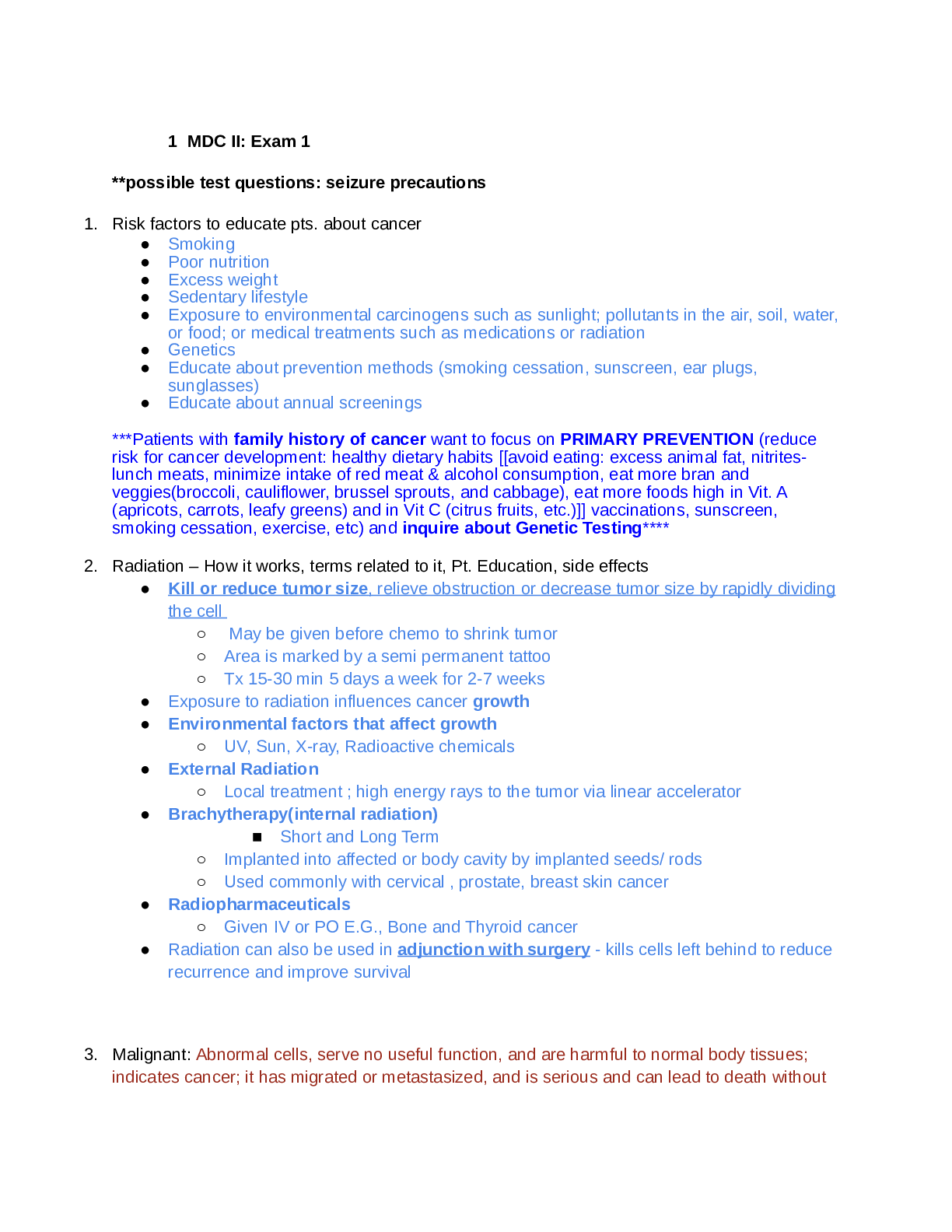

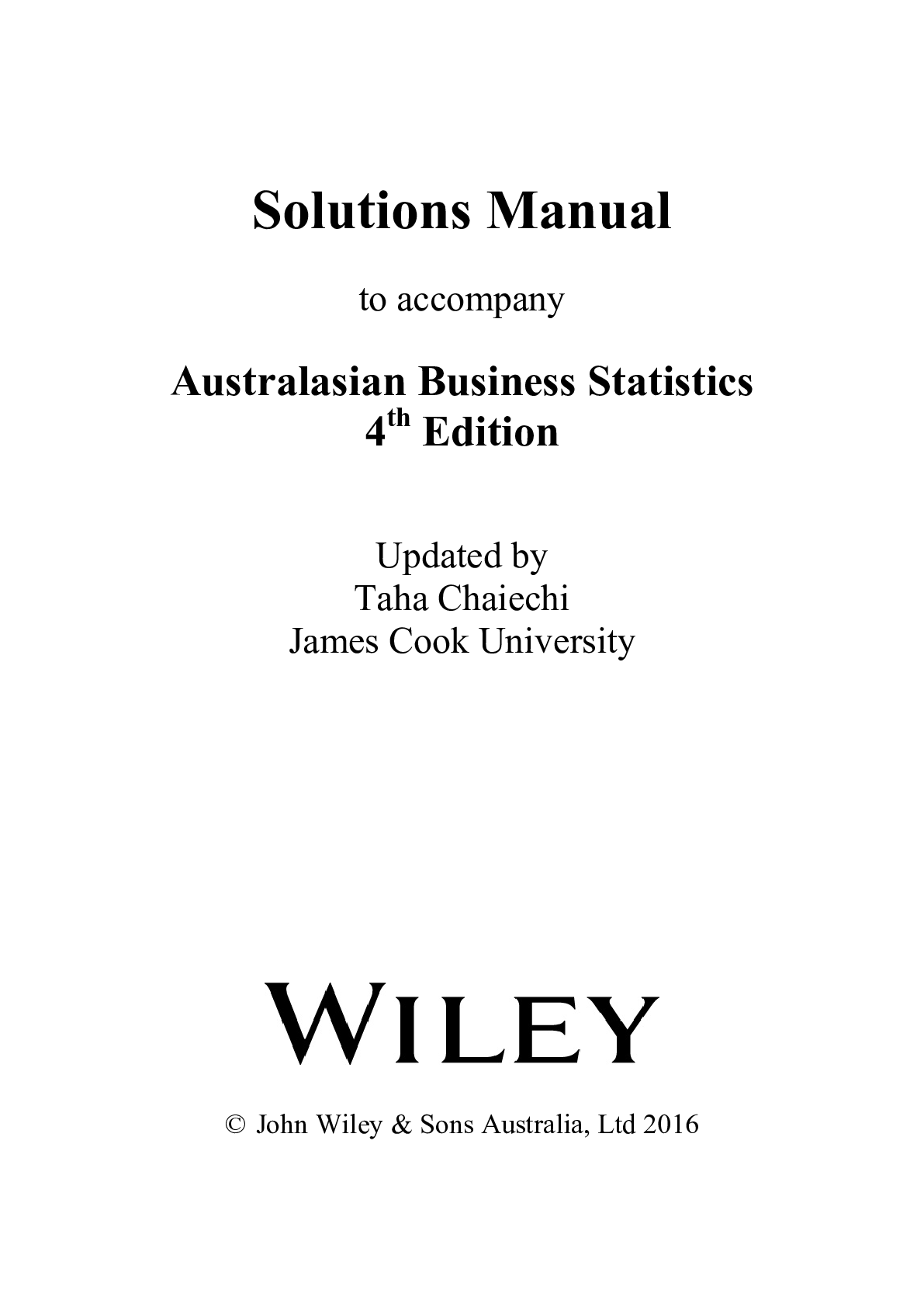

.png)
